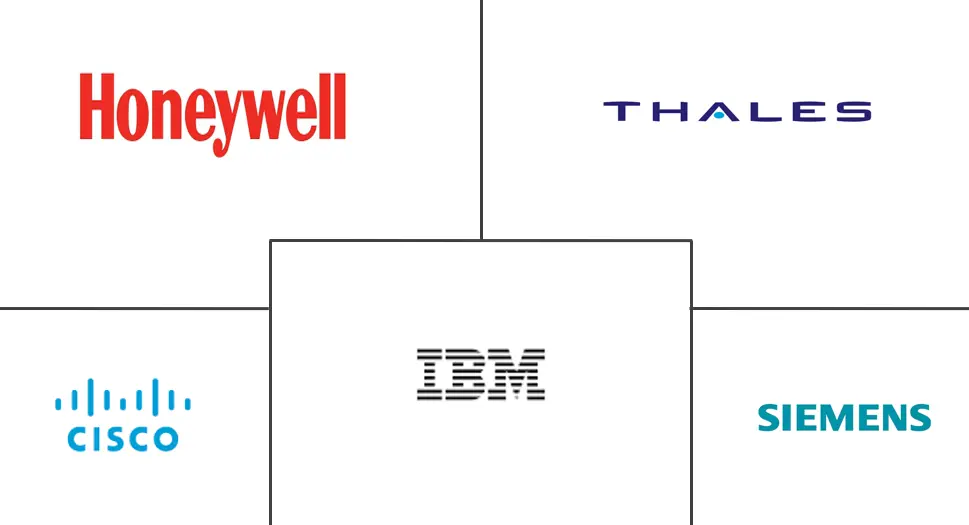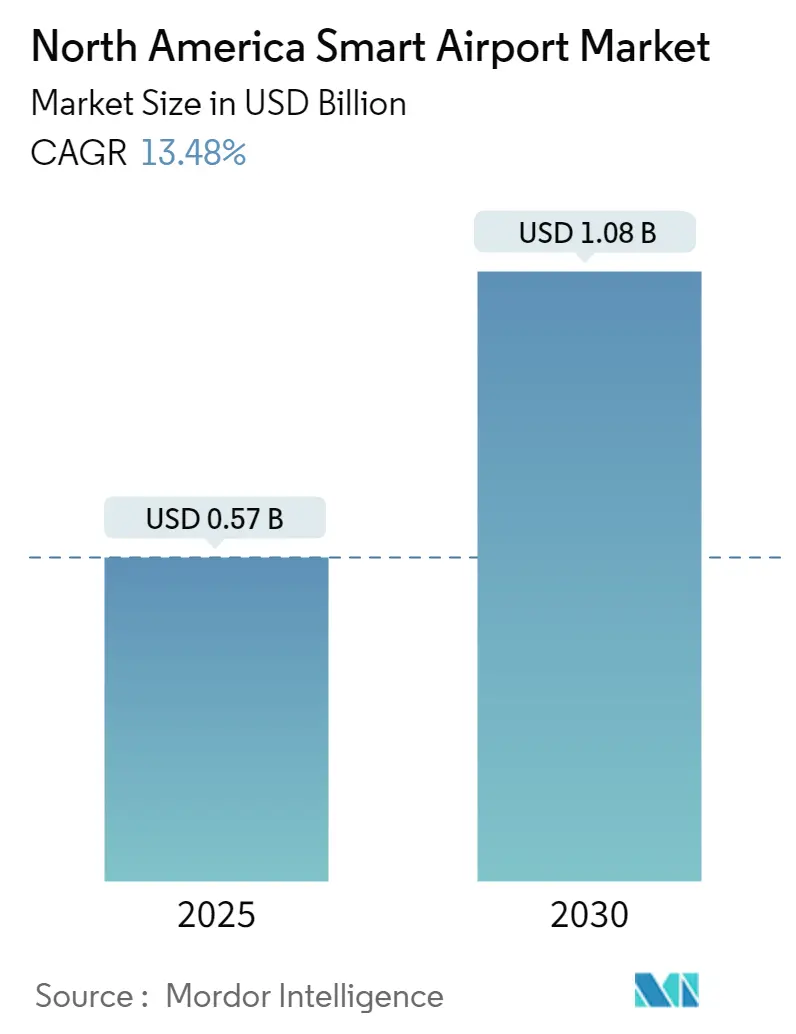
North America Smart Airport Market Analysis by Mordor Intelligence
The North America Smart Airport Market size is estimated at USD 0.57 billion in 2025, and is expected to reach USD 1.08 billion by 2030, at a CAGR of 13.48% during the forecast period (2025-2030).
The COVID-19 pandemic has severely impacted the global aviation industry. The adverse impacts of the pandemic resulted in huge supply-demand issues and delayed activities of smart airport operations globally. The airlines faced unmatched challenges due to travel restrictions and a reduced number of air passengers which resulted in a decline in revenues. The market showcased a strong recovery post-COVID due to increased investment in the digitalization of airports.
The smart airport concept became the future of airport operations, and it can completely change the aviation sector toward adapting to modern technologies. The number of people opting for air travel has increased in the past few years which has resulted in increased pressure on airports and airlines to opt for advanced systems that can enhance their ground operations and support their motive to reduce aircraft turnaround time. Smart airport systems also provide numerous advantages such as they reduce physical human work, speeding up airport operations, and minimizes the environment's negative impact.
Increasing automation of the system is expected to revolutionize the entire process flow architecture in airports. Airports are using technologies such as artificial intelligence (AI) and predictive analysis for a wide range of applications, from customer service to operational efficiency.
North America Smart Airport Market Trends and Insights
Air and Ground Traffic Control Segment is Estimated to Show Remarkable Growth During the Forecast Period
- The air and ground traffic control segment will showcase significant growth during the forecast period. The growth is attributed to the increasing expenditure on the modernization of airports and the growing use of advanced systems for airport operations in the United States and Canada.
- The rapid growth of air traffic has necessitated airports to become highly adaptive, entrepreneurial, and proactive in addressing the ever-changing dynamics of the aviation industry in North America. With the airports developing into multi-nodal transportation hubs for passengers, efforts are being divested towards developing systems and processes that are digitally aware, interconnected, infused with intelligence, and easily accessed by all stakeholders.
- For instance, the US Department of Transportation's Federal Aviation Administration (FAA) started investing the first USD 1 billion in funding to modernize the country's air traffic control system in April 2022. The funding is part of a total of USD 5 billion invested to maintain and replace air traffic control buildings and equipment nationwide. Thus, growing expenditure on the enhancement of airports and emerging adoption patterns are anticipated to drive the development of smart airports in North America during the forecast period.
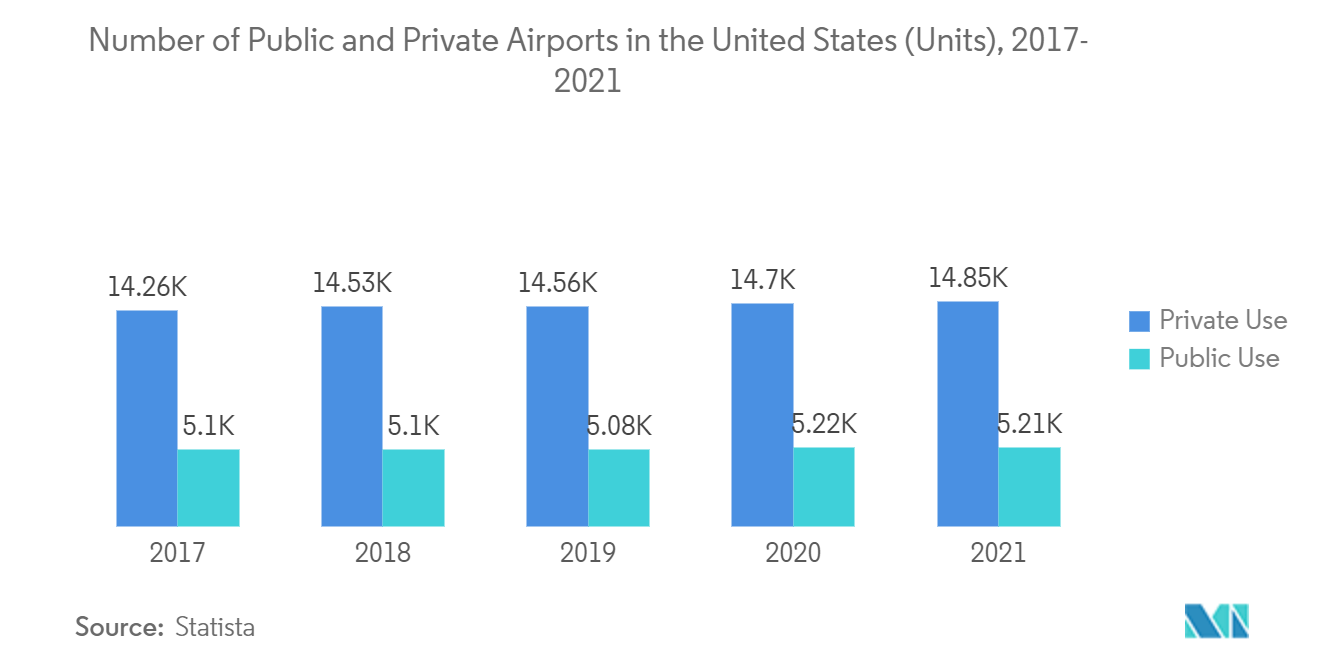
The United States is Projected to Dominate the Market During the Forecast Period
- The US held the highest shares in the North American smart airport market and is anticipated to continue its dominance in terms of market share during the forecast period. The growth is due to increased spending on the aviation sector and the presence of the highest number of airports across the United States. To efficiently handle increasing passenger traffic, ensure seamless operations, and enhance the customer satisfaction index, airports are revamping their operations to include several IoT-powered systems.
- For instance, in March 2023, The US Federal Aviation Administration (FAA) awarded USD 20 million from President Biden's Bipartisan Infrastructure Law to 29 airport-owned traffic control towers nationwide. The investment will be used to upgrade and build control towers in small towns and regional airports.
- Also, in May 2021, Raytheon Intelligence & Space signed a five-year contract worth USD 318 million with the Transportation Security Administration (TSA) to expand the deployment of checked baggage screening equipment to all federally managed airports nationwide. The construction of new airports and advancements in technology in the existing airports to enhance the experience of the passengers are expected to drive market growth across the US.
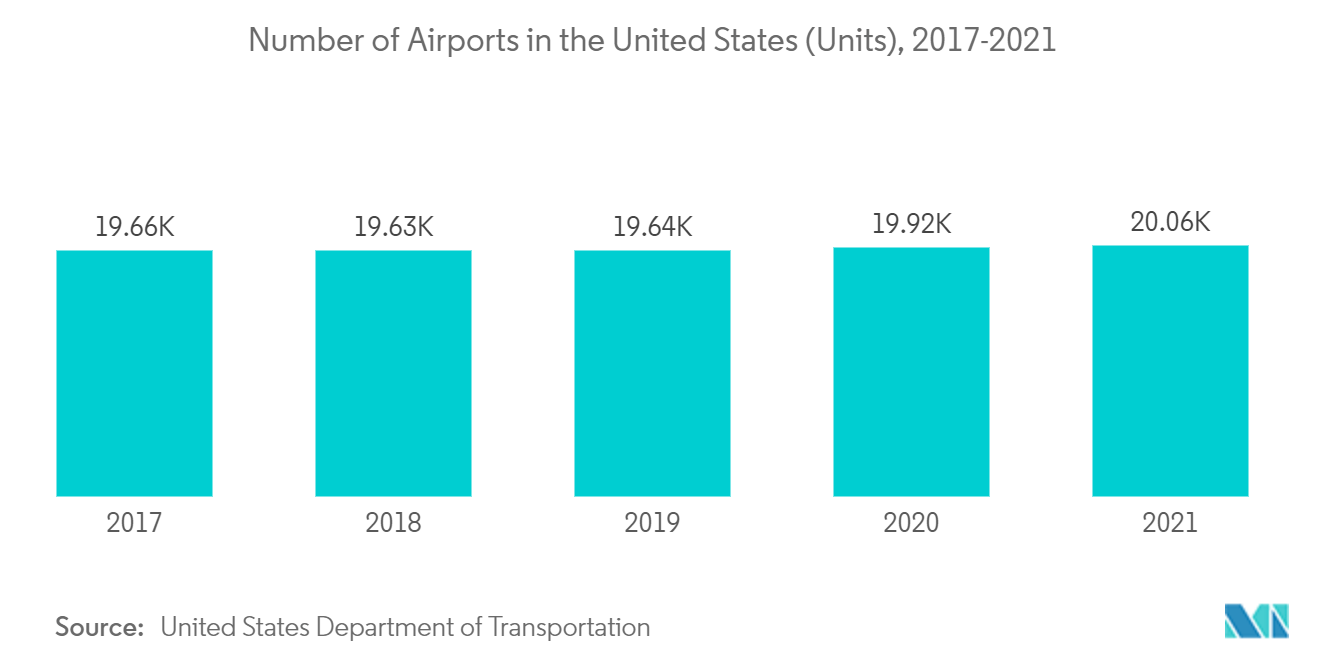
Competitive Landscape
The North American smart airport market is highly consolidated in nature, with few players holding significant shares in the market. The stringent safety and regulatory policies in the aviation sector are expected to restrict the entry of new players. Furthermore, the sales of technology-based platforms such as automated baggage handling systems and full-body scanners are primarily influenced by the prevalent economic conditions in dominant markets like the United States. Hence, during an economic downturn, purchases may be subjected to deferral or cancelation and lead to a relatively slower rate of adoption, which, in turn, can adversely affect the market dynamics.
Moreover, business uncertainty may be enhanced by failures or delays in obtaining licenses and certifications for export, which can have an adverse effect on the businesses and operating results of market players. Furthermore, the diversification of geographical markets, in tandem with the product offerings, will be a key criterion for ensuring profitability and survival in the long run.
North America Smart Airport Industry Leaders
Cisco Systems Inc.
Honeywell International Inc.
IBM Corporation
Siemens AG
THALES
- *Disclaimer: Major Players sorted in no particular order
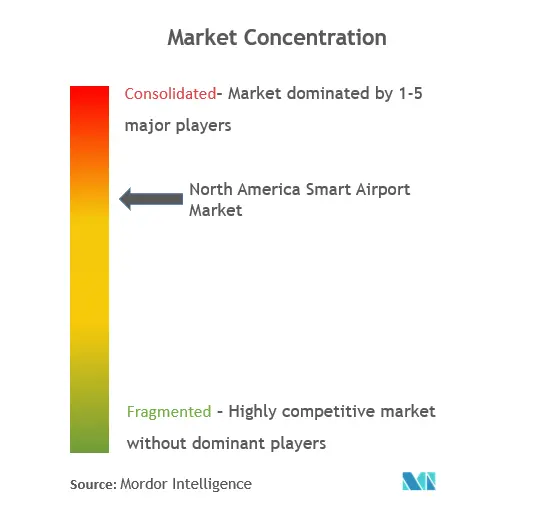
Recent Industry Developments
- February 2023: Leidos was awarded a contract by the US Transportation Security Administration (TSA) to upgrade TSA's full fleet of provision advanced imaging technology (AIT) systems used at airport security checkpoints with a new artificial intelligence (AI)-based algorithm. It helps improve airport security with an enhanced threat detection methodology that significantly reduces false alarms.
- March 2022: Thales received a contract from the airport management group SEA (Società per azioni Esercizi Aeroportuali) to deliver an innovative digital platform solution that will support the group in enhancing operational efficiency. The scalable digital platform will centralize and analyze large volumes of operational data to provide a real-time, accurate view of airport operations.
North America Smart Airport Market Report Scope
Smart airports are designed to integrate several data channels, including Wi-Fi and 4G, to allow for unified cloud-based communications, video, Internet of Things (IoT), and big data platforms. Smart airports use an array of technologies to improve their efficiency and connectivity, ranging from integrated sensors for monitoring temperature and lighting, smart baggage tags for tracking and directing luggage to the aircraft, biometric check-ins with facial recognition, and cargo warehousing management.
The North American smart airport market is segmented by technology and country. By technology, the market is segmented into security systems, communication systems, air/ground traffic control, and passenger, cargo, and baggage control, ground handling systems. By airport location, the market is segmented into the landside, airside, and terminal side, and by geography, the market is divided into the United States and Canada.
The report offers the market size and forecasts by value (USD million) for all the above segments.
| Security Systems |
| Communication Systems |
| Air/Ground Traffic Control |
| Passenger, Cargo and Baggage Control, and Ground Handling Systems |
| Landside |
| Airside |
| Terminal Side |
| United States |
| Canada |
| Technology | Security Systems |
| Communication Systems | |
| Air/Ground Traffic Control | |
| Passenger, Cargo and Baggage Control, and Ground Handling Systems | |
| Airport Location | Landside |
| Airside | |
| Terminal Side | |
| Geography | United States |
| Canada |
Key Questions Answered in the Report
How big is the North America Smart Airport Market?
The North America Smart Airport Market size is expected to reach USD 0.57 billion in 2025 and grow at a CAGR of 13.48% to reach USD 1.08 billion by 2030.
What is the current North America Smart Airport Market size?
In 2025, the North America Smart Airport Market size is expected to reach USD 0.57 billion.
Who are the key players in North America Smart Airport Market?
Cisco Systems Inc., Honeywell International Inc., IBM Corporation, Siemens AG and THALES are the major companies operating in the North America Smart Airport Market.
What years does this North America Smart Airport Market cover, and what was the market size in 2024?
In 2024, the North America Smart Airport Market size was estimated at USD 0.49 billion. The report covers the North America Smart Airport Market historical market size for years: 2019, 2020, 2021, 2022, 2023 and 2024. The report also forecasts the North America Smart Airport Market size for years: 2025, 2026, 2027, 2028, 2029 and 2030.
Page last updated on:
North America Smart Airport Market Report
Statistics for the 2025 North America Smart Airport market share, size and revenue growth rate, created by Mordor Intelligence™ Industry Reports. North America Smart Airport analysis includes a market forecast outlook for 2025 to 2030 and historical overview. Get a sample of this industry analysis as a free report PDF download.
